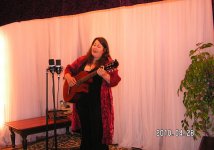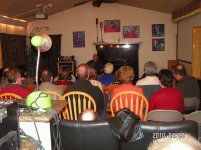Hi sofaspud,
😀
Thank you, but I didn`t say you should agree.Yes, I'm with you 100% on this. I said I was having trouble keeping a handle on it all. I came to my senses and stated the need to keep the two (objective & subjective) separate.
😀
Hi,
You mean approximately like this?:
................................
It meets MY OWN definition of HiFi just fine.
Funnily enough, by modern standards the system shown would not be considered "low distortion", nor does it manage 20Hz - 20KHz (it does do 26Hz - 40KHz though, including speakers). And the Amplifiers are emphatically NOT class D either.
Ciao T
Every so often someone does a demo where they have a live musical performance stop and a recording take over. If the room acoustics are proper no one notices.
You mean approximately like this?:
................................
An externally hosted image should be here but it was not working when we last tested it.
................................Does that meet the definition of high fidelity?
It meets MY OWN definition of HiFi just fine.
Funnily enough, by modern standards the system shown would not be considered "low distortion", nor does it manage 20Hz - 20KHz (it does do 26Hz - 40KHz though, including speakers). And the Amplifiers are emphatically NOT class D either.
Ciao T
Last edited:
My pictures don't look so nice like yours, but when after concert of Sergey Zadvodny (R.I.P.) we were sitting around the table I switched on record of the concert (tape, actually), and Sergey started speaking from the record, his concertmaster turned her head to real Sergey replying, as if she heard him speaking right here and now. 😉
You can see on the picture with Michael Feldman a tube amp on top of the rack (my Pyramid-V prototype), to the left from him, and on the picture of Angela Steingardt a couple of my large diaphragm mic prototypes. On a kitchen counter you may see a side of a mixer with digital reverberator on top.
You can see on the picture with Michael Feldman a tube amp on top of the rack (my Pyramid-V prototype), to the left from him, and on the picture of Angela Steingardt a couple of my large diaphragm mic prototypes. On a kitchen counter you may see a side of a mixer with digital reverberator on top.
Attachments
Hi,
It's all in the Camera. I bought a nice Olympus DSLR a few years back, learned from the website of a Polish-American guy the tricks for that model (last SLR I used was a Practica)... I just point the thing and click the button, it takes the pictures all by itself...
A tube Amp!? Surely it cannot be HiFi... (tounge firmly in cheek)...😛
The digital reverb looks Behringer to me... Tsk, tsk, tsk...
Ciao T
My pictures don't look so nice like yours
It's all in the Camera. I bought a nice Olympus DSLR a few years back, learned from the website of a Polish-American guy the tricks for that model (last SLR I used was a Practica)... I just point the thing and click the button, it takes the pictures all by itself...
You can see on the picture with Michael Feldman a tube amp on top of the rack (my Pyramid-V prototype), to the left from him, and on the picture of Angela Steingardt a couple of my large diaphragm mic prototypes. On a kitchen counter you may see a side of a mixer with digital reverberator on top.
A tube Amp!? Surely it cannot be HiFi... (tounge firmly in cheek)...😛
The digital reverb looks Behringer to me... Tsk, tsk, tsk...
Ciao T
The digital reverb looks Behringer to me... Tsk, tsk, tsk...
So what? 😀
It's algorithms I believe are stolen from best Lexicons.

And it is STEREO! 😉
The "secret" to recreating realism is either use a reasonably dead room and position the loudspeakers to aim exactly at the single listeners ears, (Of course you have to tweak the room, gear, etc.) or use a live room with acoustics reasonably correct for the type of music and have a special recording with little reverb of it's own. Both techniques work and have their adherents.
Demo rooms try for the first type. I prefer the second. (What percent of live performances do you think are unamplified today?)
Since the live vs recorded demo has been used for years with gear not as good as what is available today does that hint that the acoustics are the most important remaining issue.
I just digitally modified a wall at my house! I turned it from a 1 into a 0! That produced an improvement in the low frequency response and added significant reverb changes.
Demo rooms try for the first type. I prefer the second. (What percent of live performances do you think are unamplified today?)
Since the live vs recorded demo has been used for years with gear not as good as what is available today does that hint that the acoustics are the most important remaining issue.
I just digitally modified a wall at my house! I turned it from a 1 into a 0! That produced an improvement in the low frequency response and added significant reverb changes.
Last edited:
Not in the context of amplifiers, no, I have to disagree. It's the minimization of the difference between output and input that defines high fidelity for an amplifier.
Now, that should NOT be conflated with the idea (mistaken) that high fidelity in an amplifier is always an engineering goal in an overall system context. One excellent example would be the Carver subwoofer- in order that the system achieve its targeted performance, an amplifier was used that had an output that in no way resembled the input. The overall system was high fidelity, but the amplifier could in no way be called a high fidelity amplifier. Its highly nonlinear performance was part of an overall successful system design (a damn clever one, IMO).
What about being a true voltage source ?
The "secret" to recreating realism is either use a reasonably dead room and position the loudspeakers to aim exactly at the single listeners ears, (Of course you have to tweak the room, gear, etc.) or use a live room with acoustics reasonably correct for the type of music and have a special recording with little reverb of it's own. Both techniques work and have their adherents.
The third one: use open baffle speakers. They somehow blend together both reverberations.
The forth one: use the same room in which the concert was recorded. 😀
I don't understand what you're asking.
A true voltage source:
16 ohm - 40 v
8 ohm - 40 v
4 ohm - 40 v
2 ohm - 40 v
regards,
My Iceamp is near that, as it has very low output impedance. Not perfect on the top, tho, like a lot of filtered amps.
If the amp is supposed to be a voltage source, it should be a voltage source. High fidelity (in the context of an amp!) would then mean that the transfer function Vo/Vi is close to a fixed number. Likewise, if it's supposed to be a current source, Io/Vi should be close to a fixed number for the amplifier to be "high fidelity."
Again, though, whether or not high fidelity amplification is appropriate depends on engineering goals and overall system design.
Again, though, whether or not high fidelity amplification is appropriate depends on engineering goals and overall system design.
There is a thread currently on Gearslutz where recording engineers discuss proper transformers for sound recording. The point is, when transformers saturate on lows sound is more "focused" than when lows are rolled off. And they indeed are rolled off when reproduced on real speakers, through real amps. Especially, when 20 Hz is considered as minimum audible, and lows roll off with huge phase incoherence.
My Iceamp is near that, as it has very low output impedance. Not perfect on the top, tho, like a lot of filtered amps.
We already come to conclusion that class D amp has to be powered either from batteries, or from parallel shunt regulator. However, parallel shunt regulator means than such advantage of class D amp as power efficiency goes away...
I certainly have not come to that conclusion. I've run them that way, but it's not the only way to get them to work well. A purpose built SMPS right on board also seems to do well.
I certainly have not come to that conclusion. I've run them that way, but it's not the only way to get them to work well. A purpose built SMPS right on board also seems to do well.
That's why I think it is "not perfect on the top", as you were saying.
Nope. I wasn't clear.
I meant that the voltage will vary at the top end with varying load. Well known in this type of Class-D. Nothing to do with power supply, it's the low pass filter on the output.
I meant that the voltage will vary at the top end with varying load. Well known in this type of Class-D. Nothing to do with power supply, it's the low pass filter on the output.
Hi,
Quote:
Originally Posted by simon7000 View Post
Every so often someone does a demo where they have a live musical performance stop and a recording take over. If the room acoustics are proper no one notices.
You mean approximately like this?:
Your kidding right? A horn is so directional the only people in the room that wont notice are the ones in a very small angle that recreates the recording. And since most instruments (including the voice) are directional this holds true to some degree for any recording. (if your sitting of to the side in a live unamplified gig, it will sound very different than in the middle, not so with a good playback system)
Last edited:
You are suggesting that Tube Amplifiers are in demand because they change the sound in a way this is audible, yes?
Did you think about this statement very long? If they dont, why would anyone want one?
- Status
- Not open for further replies.
- Home
- Amplifiers
- Solid State
- What happened to the "digital amp revolution"?


